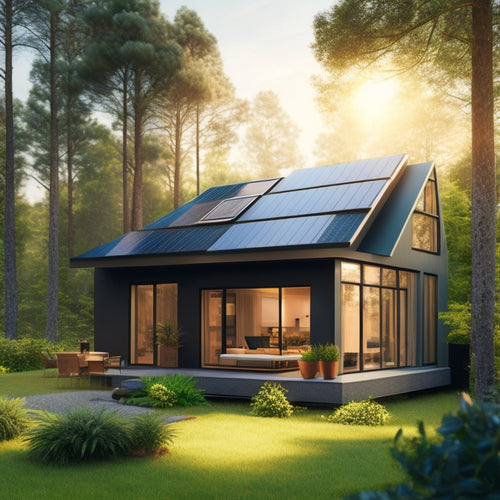
What Winter Prep Means for Solar Panel Efficiency
Share
You can maintain peak solar panel efficiency during winter by taking proactive measures to prevent snow and debris accumulation, adjusting your panel's angle and tilt, and implementing a regular cleaning and maintenance schedule. Start by inspecting your panels for signs of damage and verifying secure connections. Adjust the panel angle to match the location's latitude and seasonal sun shifts. Regularly clean your panels to prevent snow and debris buildup, and consider investing in snow-repellent coatings or specialized cleaning systems. By following these steps, you'll be well on your way to maximizing energy output - and there's more to explore to guarantee your solar panels perform at their best.
Key Takeaways
• Pre-winter inspections are crucial to identify and fix potential issues that can impact solar panel efficiency during winter.
• Snow and debris removal strategies, like using soft-bristled brushes and snow rakes, can help maintain energy production during winter.
• Adjusting panel angle and tilt according to the location's latitude and seasonal sun shifts can optimize energy output.
• Regular cleaning schedules and strategies, such as brushing off debris and using water-conserving methods, can ensure peak energy production.
• Energy output optimization through regular audits, performance monitoring, and predictive maintenance can help minimize energy losses during winter.
Pre-Winter Inspection Checklist
Before winter sets in, inspect your solar panels to guarantee they're in top condition by following this pre-winter inspection checklist.
You want to verify your system can withstand harsh weather conditions, so this is crucial to check the weather resistance of your panels.
Start by inspecting the panels' surface for any signs of damage, cracks, or corrosion. Make sure the panels are securely fastened to the roof or ground, and that all seals and gaskets are in good condition.
Next, inspect the electrical connections to confirm they're secure and not damaged.
Check for any signs of overheating, wear, or corrosion on the connectors, wires, and inverters. Verify that all connections are tightened properly, and that there are no loose wires or components.
Also, inspect the grounding system to confirm it's functioning correctly.
Snow and Debris Removal Tips
When snow and debris accumulate on your solar panels, they can drastically reduce energy output, so you must remove them promptly to maintain peak efficiency.
To facilitate safe and effective removal, consider the following tips:
First, plan ahead and prioritize roof access to facilitate easy cleaning. Guarantee you have a safe and stable means of accessing your roof, such as a ladder or scaffolding, to minimize the risk of accidents.
Next, inspect your panels regularly to catch snow and debris buildup before it becomes a major issue.
When removing snow, use a soft-bristled brush or a snow rake specifically designed for solar panels to avoid damaging the surface. Be mindful of snow load, taking care not to apply excessive pressure that could compromise your panels' structural integrity.
Finally, consider investing in a snow-repellent coating or a solar panel cleaning system to make future maintenance easier and more efficient.
Panel Angle and Tilt Adjustment
You can optimize your solar panel's energy output by adjusting the panel angle and tilt to match your location's latitude and seasonal changes. This is vital during winter prep, as the sun's position in the sky changes throughout the year. By making adjustments, you can maximize energy production and reduce losses.
To get the most out of your solar panels, consider the following:
Latitude-based tilt: Adjust the tilt of your panels to match your location's latitude. This guarantees the panels are at the ideal angle to capture sunlight.
Seasonal shift adjustment: Adjust the panel angle to account for the sun's seasonal shift. During winter, the sun is lower in the sky, so adjusting the panels to a steeper angle can help capture more energy.
Angular optimization: Use software or consult with a professional to determine the ideal angle and tilt for your specific location and panel type.
Regular adjustments: Regularly check and adjust your panel angle and tilt to maintain peak energy production throughout the year.
Cleaning Strategies for Winter
After optimizing your solar panel's angle and tilt, focus on maintaining cleanliness to maximize energy output, as winter's snow, ice, and debris can severely impact performance.
You'll want to develop a regular cleaning schedule to guarantee your panels operate at peak efficiency. Start by brushing off loose debris, such as leaves or twigs, to prevent snow and ice from accumulating.
When it comes to de-icing methods, consider using a soft-bristled brush or a specialized snow rake to gently remove snow and ice. Avoid using harsh chemicals or abrasive materials, as they can damage your panels.
Additionally, prioritize water conservation by using a hose with a spray nozzle to minimize water usage. For more thorough cleanings, consider investing in a water-recycling system or using a cleaning solution specifically designed for solar panels.
Energy Output Optimization
Optimizing energy output requires careful monitoring of your solar panel system's performance, as even slight deviations from ideal conditions can substantially impact energy production.
To maximize your energy output, you need to identify areas of improvement through energy auditing and performance benchmarking. This involves analyzing your system's performance data to identify trends, patterns, and anomalies that can affect energy production.
Conduct regular energy audits: Identify energy losses and inefficiencies in your system to optimize energy production.
Monitor performance benchmarks: Compare your system's performance to industry standards and ideal conditions to identify areas for improvement.
Adjust system settings: Fine-tune your system's settings to optimize energy production based on changing weather conditions and seasonal variations.
Perform predictive maintenance: Identify potential issues before they occur, and schedule maintenance to minimize downtime and maximize energy production.
Frequently Asked Questions
Can Solar Panels Still Generate Power During a Blackout?
You can still generate power during a blackout with solar panels, achieving grid independence and energy security, as long as you have a battery storage system and an inverter that allows for off-grid functionality.
Do Solar Panels Work Better in Cold or Warm Weather?
As you wonder about solar panel performance, here's the deal: they work more efficiently in cold weather, thanks to lower Temperature Coefficients, which means you'll see a boost in Energy Output when it's chilly outside.
Will Solar Panels Last Longer in Colder Climates?
You'll be pleased to know that solar panels can thrive in colder climates, as their Climate Durability and Cold Hardiness guarantee they'll last longer, with some lasting up to 30 years or more in frozen temperatures.
Can I Install Solar Panels on a Metal Roof?
You can install solar panels on a metal roof, but verify the roof material is compatible with the solar panel mounting system, and consider metal compatibility to avoid corrosion or damage.
Are There Solar Panels Designed Specifically for Winter?
'Will you let winter weather diminish your solar panel's performance? Luckily, yes, there are solar panels designed specifically for winter, featuring Winter Optimization and Frost Resistance to guarantee maximum energy harvesting even in freezing temperatures.'
Related Posts
-

10 Essential Bike Lane Safety Features to Consider
You're designing a bike lane with safety in mind, and that's essential. The National Highway Traffic Safety Administr...
-

What You Need to Know About RV Solar Maintenance
When you're out on the road, your RV's solar panel system is your lifeline. But without regular maintenance, you're l...
-

Reduce Solar Panel Cost for Your Small Home
By evaluating your energy needs, choosing the right installer, and selecting cost-effective solar panel options, you ...


